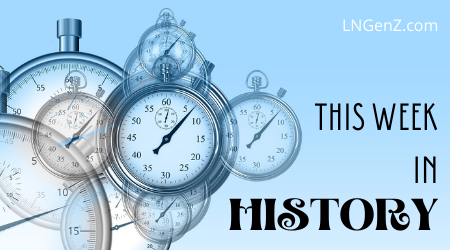This Week in History: July 3 – 9
The signing of the Declaration of Independence.
By: Kelli Ballard | July 3, 2022 | 866 Words

(Photo by: Christophel Fine Art/Universal Images Group via Getty Images)
“If you don’t know history, then you don’t know anything. You are a leaf that doesn’t know it is part of a tree.” ~ Michael Crichton
July 4, 1776: The Declaration of Independence
As we celebrate the Fourth of July, it’s important to understand what we’re honoring and why. Before 1776, the beginnings of what is now the United States was just a group of British colonies. The colonists grew tired of what they called “taxation without representation,” especially after the Stamp Act was enacted, so they started to rebel.
Thomas Paine, in January 1776, published Common Sense, a political pamphlet that argued for independence from Britain. In just a few months, more than 500,000 copies were sold, and support for the movement swept the colonies. The Continental Congress asked the states to create their own governments and then developed a five-man committee with the task of coming up with a formal declaration.
Thomas Jefferson, who would become the third president of the US, is considered the Author of Independence because he wrote the majority of the Declaration of Independence. The most famous line is the first sentence of the second paragraph:
“We hold these truths to be self-evident, that all men are created equal, that they are endowed by their Creator with certain unalienable Rights, that among these are Life, Liberty and the pursuit of Happiness.”
At the time, England controlled 13 colonies in America, which was also often called the New World. It was these colonies, which later became states, that rebelled against Britain: Connecticut, Delaware, Georgia, Maryland, Massachusetts, New Hampshire, New Jersey, New York, North Carolina, Pennsylvania, Rhode Island, South Carolina, and Virginia.
The Revolutionary War, which is also known as the American Revolution, started in 1775. The Continental Congress, on July 2, 1776, voted to approve a motion to separate from Britain. Just two days later, on July 4, 1776, the Declaration of Independence was formally adopted by 12 of the 13 states. New York didn’t officially adopt it until July 19. The declaration was signed on August 2, but the war would continue for another five years. In 1778, the French joined the Colonists’ side, effectively turning the war in their favor, and in 1781, the Americans won their independence.
Other Notable Mentions
July 3, 1775: George Washington became the commander of the Continental Army at Cambridge, Massachusetts during the Revolutionary War.
July 3, 1976: an Israeli commando unit, during a raid on Entebbe airport in Uganda, rescued 103 hostages that had been on a hijacked Air France airliner.
July 4: Independence Day. A federal holiday to celebrate America’s independence from Great Britain.
July 4, 1863: After a six-week siege, Vicksburg, the last stronghold for the Confederates on the Mississippi River, surrendered to General Ulysses S. Grant during the Civil War.
 July 4, 1882: The “Last Great Buffalo Hunt” began in North Dakota on reservation lands. About 2,000 Teton Sioux Indians hunted around 5,000 buffalo.
July 4, 1882: The “Last Great Buffalo Hunt” began in North Dakota on reservation lands. About 2,000 Teton Sioux Indians hunted around 5,000 buffalo.
July 5, 1775: In hopes of reconciling with Britain, the Continental Congress adopted the Olive Branch Petition. However, King George III refused to look at it and declared the colonists were openly rebelling.
July 6, 1885: The first successful anti-rabies vaccine was given by Louis Pasteur to a boy who had been bitten by a dog infected with rabies.
July 7, 1898: President William McKinley annexed Hawaii by signing a resolution. In 1900, it became an incorporated territory of the US, and in 1959, it became a state.
July 8, 1776: Colonel John Nixon read the Declaration of Independence for the first time to a crowd in Philadelphia.
July 9, 1868: The 14th Amendment was ratified. This defined US citizenship and protected citizens’ right to due process and equal protection.
Famous Birthdays
Nathaniel Hawthorne (July 4, 1804) was born in Salem, Massachusetts. A novelist and short-story writer, he is known for many works including The Scarlet Letter and The House of the Seven Gables.
Stephen Foster (July 4, 1826) was born in Lawrenceville, Pennsylvania. He was a songwriter with such famous hits as Oh! Susanna, Beautiful Dreamer, and Swanee River.
Calvin Coolidge (July 4, 1872) was born in Plymouth, Vermont. He was the 30th US president, taking over the office after the death of Warren G. Harding.

P.T. Barnum (Photo by Smith Collection/Gado/Getty Images)
P.T. Barnum (July 5, 1810) was born in Bethel, Connecticut. Co-founder of Barnum and Bailey Circus, his museum opened in 1842 with exhibits such as the Feejee Mermaid, General Tom Thumb, and Siamese twins Chang and Eng. In 1971, he opened “The Greatest Show on Earth” in New York.
Cecil J. Rhodes (July 5, 1853) was born at Bishop’s Stortford, Hertfordshire, England. He was a millionaire and politician, and it is said he once controlled 90% of the world’s diamond production. His will created the Rhodes Scholarships at Oxford University.
John Paul Jones (July 6, 1747) was born in Kirkbean, Scotland. A Revolutionary War naval officer, he is remembered for telling the British, “I have not yet begun to fight!”
Leroy R. (Satchel) Paige (July 7, 1906) was born in Mobile, Alabama. At age 42, he became the first African American pitcher in the baseball American League. In 1971, he was inducted into the Hall of Fame.
Nelson Rockefeller (July 8, 1908) was born in Bar Harbor, Maine. He was a New York governor before becoming vice president under Gerald Ford in 1974.
















